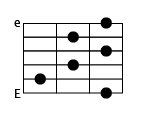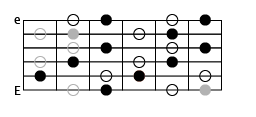working with the diminished scale
I've been working with the dimished scale lately, and I thought it might be a good idea to document how I wrap my mind around it.
First off, let's start with a diagram of a diminished scale:

The black dots represent the chord itself, while the grey dots are alternate locations to play notes of the chord. As far as fret numberings go, if you wished to play the Bb diminished scale, you would start by placing that first note at Bb, or the sixth fret. However, due to the "overlapping" nature of the diminished scale, you would also simultaneously be playing in the D, F, and Ab diminished scales.
If you start with the first black dot on the low E string, and follow the black dots left to right on each string in sequence, you'll end up playing through the octave twice, with one note left over.
The next thing to grasp is how this pattern repeats itself on the fretboard. I like to think of connection points between fretboard patterns, and this scale provides some easy ones. This next diagram illustrates where this pattern repeats; the pattern starting from the first pair of highlighted notes is repeated after the second pair of notes.

Once you understand that, the entire pattern simplifies to this:

Of course, if you ever get lost (say, mid-jam), the easiest thing is to do is remember that on any given string, the diminished notes always have two frets between them. Eventually the patterns will start to make sense again.
At this point I should mention a semantic issue. I tend to refer to the previous scale as the 'diminished scale', but that terminology is often used to describe a scale consisting of alternating whole and half steps. This is also often referred to as the octatonic scale which looks like this:

However, this isn't as complicated as it looks. You're simply adding a note a half step below every note you were playing before (indicated by the circles). It's called a diminished scale because it does, in fact, contain the entire diminished chord for the given key.
References: http://en.wikipedia.org/wiki/Diminished_scale